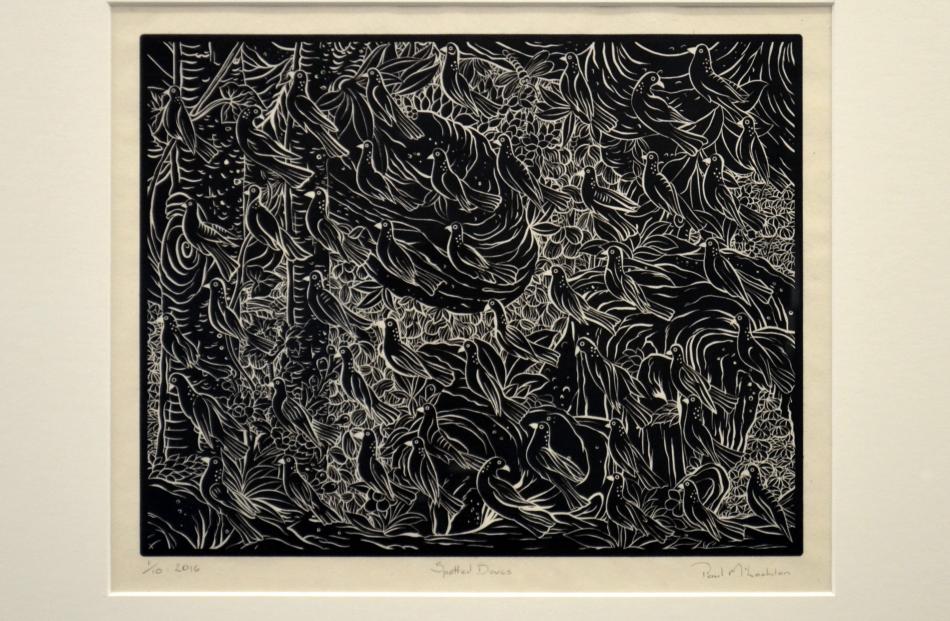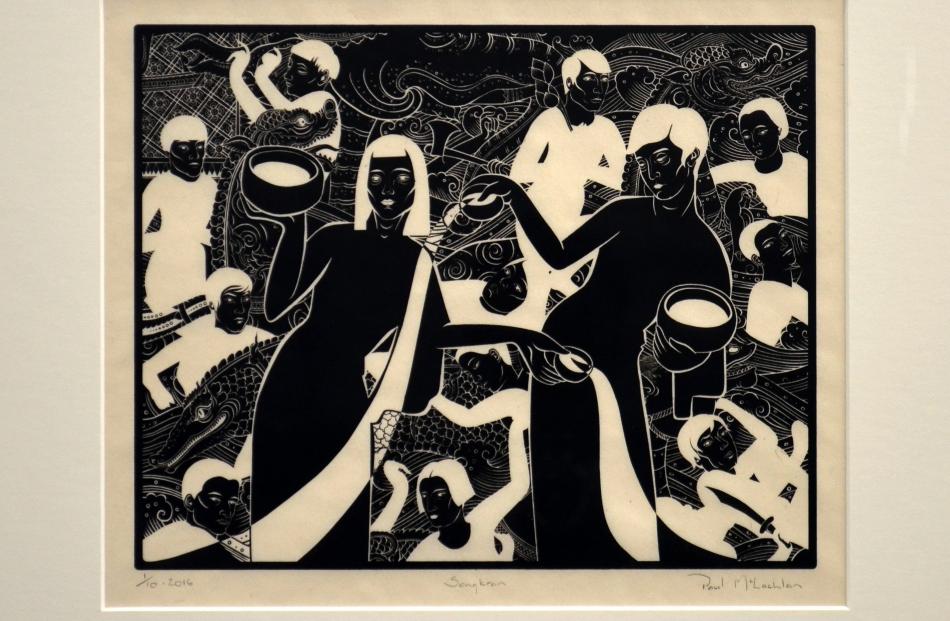Artist Paul McLachlan has said goodbye to living in Dunedin. He tells Rebecca Fox about his preference for a more nomadic lifestyle.
Paul McLauchlan exists between two worlds - he is living in Palermo, Italy, but is completing a project begun in Bangkok, Thailand, while on an Asia New Zealand Foundation residency.
The suite of 2m-wide tapestries is being created from his work in Bangkok using a computerised weaving loom and is being fabricated in the Netherlands in collaboration with a textile museum.
''The ability to operate remotely, travel and collaborate with technicians and ateliers is a very freeing and stimulating style of art practice.''
The former South Otago farm boy, who was inspired to become an artist after seeing Dunedin Public Art Gallery exhibitions Masterpieces of Guggenheim in 1997 and The Pre-Raphaelite Dream in 2003, is a contemporary artist who usually combines digital and analogue processes such as lithography or intaglio printmaking in his work.
''My previous projects explored communal understandings of New Zealand history and traditions. I have a particular interest in the collective ideals and values preserved within public artworks and memorials, and how mythologies relate to societal practices.''
Before he left for Bangkok, the Massey University, Wellington fine arts graduate in painting with honours (2009) was based in Dunedin, creating drawings and working with crusted and burnished graphite.
''Everything in my flat became smudged with grey fingerprints. Eventually my flatmate wrote a note into the dark-graphite-coated shower wall ''Time to clean''. She was wonderfully tolerant and one of the great friends I made in Dunedin.''
McLachlan, who did his master's in printmaking at the University of Canterbury (2011), had gradually become digitally dependent as a result of not having a permanent home as he moved between cities and flats, international travel and the Christchurch earthquakes.
''I relocated so many times it was simpler for my laptop to become my sole, quiet and reclusive art studio. So long as I have noise-cancelling headphones, I can shut myself off from the distractions of the world and work.
''God help anyone who interrupts me.''
Things changed after he saw ''Imagine Asia'', a retrospective exhibition of Asia New Zealand Foundation artists at Pataka, in Porirua. He felt it was a challenge he was ready for and applied for one of the three-month residencies.
''The artworks in the exhibition were dynamic and engaging.''
The foundation has run a programme of artist-in-residence opportunities in Asia since 2007, exposing New Zealand artists to new ideas and experimental art forms in Asian cities. Since 2010, the foundation has partnered with Creative New Zealand to deliver four residencies.
Asia New Zealand Foundation director of culture Jennifer King said the purpose of the residencies was to help New Zealand artists build networks in the region.
''We'd like to see New Zealanders become as familiar with traditional and contemporary Asian art forms as they are with European and North American artistic influences.''
He chose Bangkok because it had an ''alive, pulsing energy which only comes from having six million people living in one place''.
''It is also the Theravada Buddhist capital, with thousands of Buddhist temples and a rich spiritual climate that permeates every aspect of the city.''
McLachlan wanted to tap into that feeling by exploring Buddhist mythology within the everyday, the relationship between the mystic and the social and to reconcile existence and consciousness to human experience.
''This residency equipped and allowed me the luxury of concentrating all my energy and focus into my art, which is an intoxicating headspace to be in. There wasn't the numbing comfort of familiar routine, or the depressing disruptions of part-time work or rent or car troubles.
''There wasn't a day when I wasn't creating, or researching or strategising. Being an artist is all-encompassing, every day.''
However, three months is a very short amount of time to explore a city and to research and create a project, but ''this sort of frenetic time constraint inevitably leads to unexpected developments and new discoveries''.
His previous work utilised digital sculpture and virtual space, while the work he created in Bangkok became flat, using 2-D shapes and forms.
''This is perhaps an influence of the black line work of the gold leaf lacquer panels of the Ayutthaya period, or the nang yai shadow puppets, which used light and silhouettes to illustrate the epic Ramakien narratives.
''Each of my images were built up using plein air drawings, photographs, portraits of friends, found imagery and natural scenes. I wanted to create lyrical and poetic worlds that slip between light and dark, and positive and negative space.''
When not working, in the evenings he attended a Thai fitness bootcamp to ''balance out the many Thai dinners I ate'', usually cooked by his adopted Thai mother, Ah-Choo, who ran a food stall near his studio building, or he embraced the high-society nightlife of Bangkok, which ''is super-trendy, with fathoms of adventurously themed clubs and bars''.
''Bangkok is a city of extremes, and worlds within worlds.''
It came with challenges - the heat, humidity, food, transport, and communicating with a vocabulary of 10 words.
''I found the biggest challenge was distilling so much sensory overload into essential ideas and image-form. I took thousands of photos, created hundreds of free-drawings, and I did a lot of writing to help me process my daily experiences.''
One of his most memorable experiences was the Songkran, a nationwide water fight celebrating the Thai New Year with themes similar to those of Easter - transformation and new beginnings.
''Everyone is doused in water to symbolise purification and the cleansing of sins and bad luck. I have never seen a holiday festival that is celebrated so joyously by such a broad cross-section of society. The city shuts down and every person takes to the streets brandishing some form of water gun. If you are not alert, even unsuspecting old ladies will pour a cup of ice water down your back, and laugh.''
By the end of the residency, after two exhibitions, he had a collection of digital drawings, which he rendered as lithographs at the University of Canterbury print studio and showed at the Chambers Gallery in Christchurch this year.
For McLachlan, the residency at Surface Arts was life-changing.
''It bounced me out of Dunedin and gave me an incredible opportunity for personal growth. My work has developed into a new and unexpected direction, which I am really enjoying, and I have good creative momentum as my Bangkok project continues to evolve.''
He has moved to Palermo, which has a ''stimulating'' contemporary art scene that is adding a new dimension to his work.
''It is exciting to feel part of a local art movement that seems to attract artists, writers and 'creatives' from around the world, including half a dozen Fulbright artists and a contemporary dealer gallery who throws sumptuous artist-studio parties.''
McLachlan also has friends who have moved to the city from Rome to open an artist-run space, and another who is there for a few months finishing his first novel.
''It is very encouraging to feel so instantly connected and supported by a creative community.''
Italian curator Lorenzo Calamia plans to exhibit the Bangkok-inspired tapestries in Palermo next year and a public gallery in New Zealand will show them in 2018.
Coming after Bangkok, Palermo is not as unlikely a place to be developing an art project around mythology as people might think, he said.
''Palermo is a city of amalgams: the Greeks, the Arabs, Carthaginians, the Romans and Normans have all left remnants of their cultural suppositions layered and imprinted within the streets and monuments of the city.''
While his work has developed due to all the different influences over the years, his artworks are still very process driven.
''I still use a lot of found imagery and enjoy investing time into details. Figures and portraiture have always been present in my work in some form.''
As he had struggled to find a ''creative home'' in Dunedin, the residency to Bangkok ''marked a definitive end'' to his time in the city, but he says he will still return home to visit family in Wanaka.
''For now, I am happy travelling and splitting my year between Europe, Southeast Asia and New Zealand.''
















